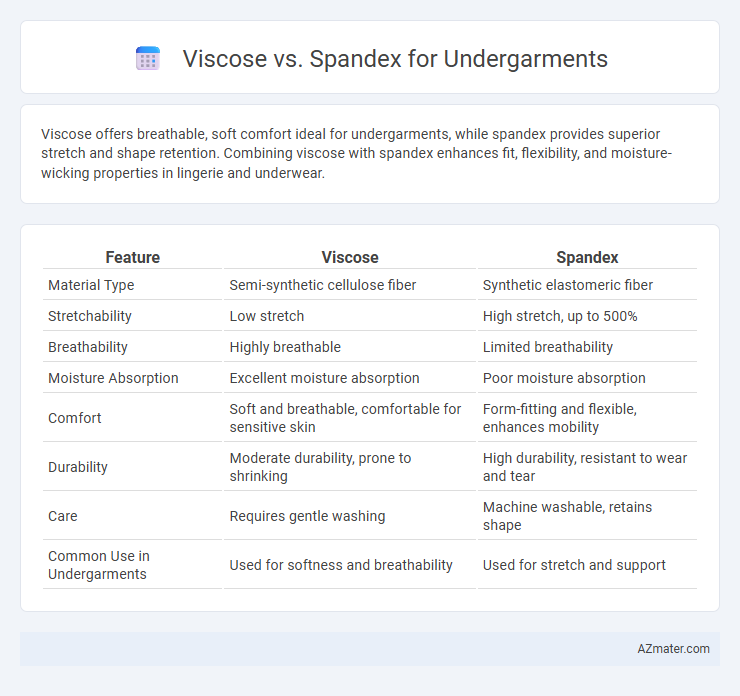Viscose offers breathable, soft comfort ideal for undergarments, while spandex provides superior stretch and shape retention. Combining viscose with spandex enhances fit, flexibility, and moisture-wicking properties in lingerie and underwear.
Table of Comparison
| Feature | Viscose | Spandex |
|---|---|---|
| Material Type | Semi-synthetic cellulose fiber | Synthetic elastomeric fiber |
| Stretchability | Low stretch | High stretch, up to 500% |
| Breathability | Highly breathable | Limited breathability |
| Moisture Absorption | Excellent moisture absorption | Poor moisture absorption |
| Comfort | Soft and breathable, comfortable for sensitive skin | Form-fitting and flexible, enhances mobility |
| Durability | Moderate durability, prone to shrinking | High durability, resistant to wear and tear |
| Care | Requires gentle washing | Machine washable, retains shape |
| Common Use in Undergarments | Used for softness and breathability | Used for stretch and support |
Introduction to Viscose and Spandex Fabrics
Viscose fabric, made from regenerated cellulose fibers, offers softness, breathability, and moisture absorption, making it ideal for comfortable undergarments. Spandex, a synthetic fiber known for its exceptional elasticity, provides stretch and shape retention, enhancing fit and support in intimate apparel. Combining viscose and spandex results in a fabric blend that balances softness with flexibility, optimizing comfort and durability in undergarment design.
Key Properties of Viscose for Undergarments
Viscose offers exceptional breathability and moisture-wicking properties, making it ideal for comfortable undergarments that keep skin dry and cool. Its soft, silky texture provides a luxurious feel against the skin, while its natural origin from cellulose fibers ensures excellent biodegradability. Viscose's lightweight and smooth finish prevents irritation, enhancing everyday wearability in sensitive areas.
Key Properties of Spandex for Undergarments
Spandex is highly valued in undergarments for its exceptional elasticity, providing superior stretch and shape retention compared to viscose. Its moisture-wicking properties and lightweight breathable nature ensure comfort and durability during extended wear. Enhanced recovery and resistance to abrasion make spandex the preferred choice in performance-focused intimate apparel.
Comfort Comparison: Viscose vs Spandex
Viscose offers superior breathability and moisture-wicking properties, making it highly comfortable for undergarments by keeping the skin dry and cool. Spandex, known for its exceptional elasticity and shape retention, provides a snug fit that moves with the body, ensuring comfort during physical activity. Combining viscose with spandex can enhance undergarment comfort by balancing softness and stretchability for all-day wear.
Breathability and Moisture Management
Viscose offers excellent breathability due to its natural cellulose fibers, making it a preferred choice for undergarments that keep skin cool and dry. Spandex enhances moisture management by providing stretch and flexibility, allowing fabrics to wick sweat away from the body efficiently. Combining viscose with spandex creates undergarments that balance airflow and moisture control for superior comfort during wear.
Durability and Longevity of Each Fabric
Viscose undergarments offer moderate durability but tend to lose shape and weaken faster due to moisture absorption and fiber breakdown over time. Spandex, known for its exceptional elasticity and resistance to wear, provides superior longevity by maintaining stretch and recovery after repeated use and washing. Combining viscose with a small percentage of spandex enhances comfort while significantly improving the durability and lifespan of undergarments.
Stretch and Fit: Which Performs Better?
Viscose offers a soft, breathable fabric but has limited stretch, making it less ideal for form-fitting undergarments. Spandex provides superior elasticity and shape retention, ensuring a snug, comfortable fit that moves with the body. For undergarments prioritizing stretch and fit performance, spandex outperforms viscose by delivering exceptional flexibility and support.
Skin Sensitivity and Hypoallergenic Qualities
Viscose offers excellent breathability and is gentle on sensitive skin due to its natural cellulose fibers, making it hypoallergenic and less likely to cause irritation in undergarments. Spandex, while providing superior stretch and shape retention, can sometimes trigger skin sensitivity or allergies due to its synthetic composition and chemical treatment. For individuals with delicate or reactive skin, viscose undergarments are often preferred to minimize discomfort and allergic reactions.
Care Instructions: Washing and Maintenance
Viscose undergarments require gentle washing in cold water with mild detergent to maintain fiber integrity and prevent shrinking, while avoiding wringing or twisting during drying. Spandex blends benefit from hand washing or machine washing on a delicate cycle in cold water, with no bleach or fabric softeners, and should be air-dried flat to preserve elasticity and fabric stretch. Proper maintenance of both fabrics enhances durability, comfort, and shape retention in undergarments.
Environmental Impact: Viscose vs Spandex
Viscose, derived from cellulose fibers, is biodegradable but involves chemically intensive production processes that can harm water sources without proper management. Spandex, a synthetic polymer made from fossil fuels, is non-biodegradable and contributes to microplastic pollution when washed. Choosing viscose over spandex for undergarments offers a lower long-term environmental footprint, provided sustainable manufacturing practices are employed.

Infographic: Viscose vs Spandex for Undergarment
 azmater.com
azmater.com